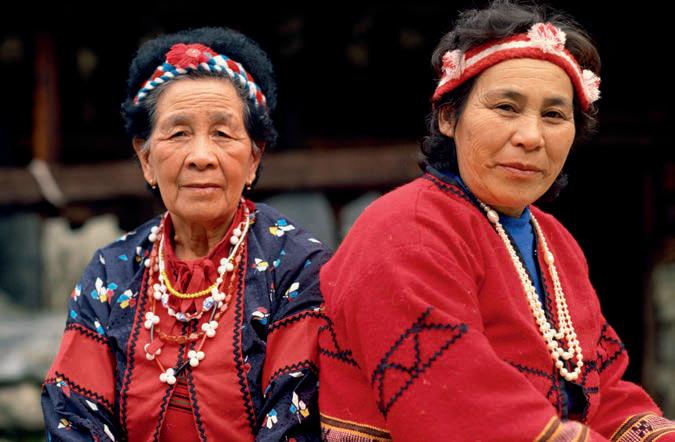Taiwan

While the dominant culture on the island of Taiwan is Mandarin Chinese, many Indigenous peoples have contributed to the island's character. The Chinese only settled en masse in the 17th century, by which time its original Austronesian-descended inhabitants had been there for over 4,000 years. As such, a vast proportion of Taiwanese today have some Indigenous heritage.
In total, Taiwan has sixteen recognised ethnic groups, totalling over 550,000 people. This amounts to just 2.4% of the population, yet their influence on the island is far more than that suggests, not least through crafts, food and music - Abao being the most famous Indigenous singer.
For years, these peoples were marginalised, referred to as shanbao (mountain people); they were only named in the constitution as yuanzhumin (original inhabitants) in 1994. However, since President Tsai Ing-wen came to power, positive steps have been made. On 1 August (Indigenous People's Day) in 2016, she made a formal apology: "For 400 years, every regime that has come to Taiwan has brutally violated the rights of Indigenous peoples through armed invasion and land seizure. For this, I apologise to the Indigenous peoples on behalf of the government."
President Tsai also has a Paiwan grandmother and is the first Taiwanese leader to proclaim her ethnic heritage. In addition, 16 recognised Indigenous languages have now been adopted as national languages within Taiwan.
Visits to the coastal strip east of the central mountain ridge take you to the area populated by the largest Indigenous group on the island, the Amis. They are famed for their harvest festivals in the summer, with celebrations spanning around 40 communities during the months of July and August. Not all welcome uninvited guests (or women), but those that do claim a seat will witness age-old dances and rituals being passed down between generations.
この記事は Wanderlust Travel Magazine の February/March 2023 版に掲載されています。
7 日間の Magzter GOLD 無料トライアルを開始して、何千もの厳選されたプレミアム ストーリー、9,500 以上の雑誌や新聞にアクセスしてください。
すでに購読者です ? サインイン
この記事は Wanderlust Travel Magazine の February/March 2023 版に掲載されています。
7 日間の Magzter GOLD 無料トライアルを開始して、何千もの厳選されたプレミアム ストーリー、9,500 以上の雑誌や新聞にアクセスしてください。
すでに購読者です? サインイン

Vermont, USA
The Wanderlust team relocated to New England for part of this issue, as we explored a lush state filled with outdoor escapes, historic towns... and lashings of maple syrup

Unique North America
See a side to the USA and Canada beyond the big cities and discover incredible stories and special wildlife with our pick of the trips

The call of the Rockies
From historic ski lodges to rustic backcountry cabins and a mock-Scottish castle, we pick the stays in Canada's Rocky Mountains that make the most of their setting

A new dawn for the Garifuna community
When the Garifuna people settled in Belize, they had to carry their traditions and culture with them; now a new trail is inviting visitors to explore this heritage through local communities

On the edge of history
In south-west Colorado lies the largest archaeological preserve in the USA, a series of vast cliff dwellings whose residents 'vanished' overnight. But was the answer to their disappearance in plain sight?

Tigers burning bright
As India celebrates 50 years of its Project Tiger conservation scheme, we visit the reserves of Madhya Pradesh to see how its success has impacted a tiger population that once looked in danger of disappearing

SEASON'S GREETINGS
From fiery fall foliage to art fairs and harvest festivals, opens up a wealth of across the USA and Canada autumn experiences

Waking a sleeping GIANT
A slow drive along the North Wales Way, from the English border to Anglesey, reveals not only a land of incredible local food and castles, but a region that is slowly reimagining itself

The rebirth of old JEDDAH
As efforts to restore Al-Balad, Jeddah's historical district, take hold, we get an exclusive peek at how art and culture are taking centre stage

Star-studded escapes
Wilderness, history and wildlife combine at some of Britain's most iconic stargazing sites, as more and more travellers are looking to the heavens
